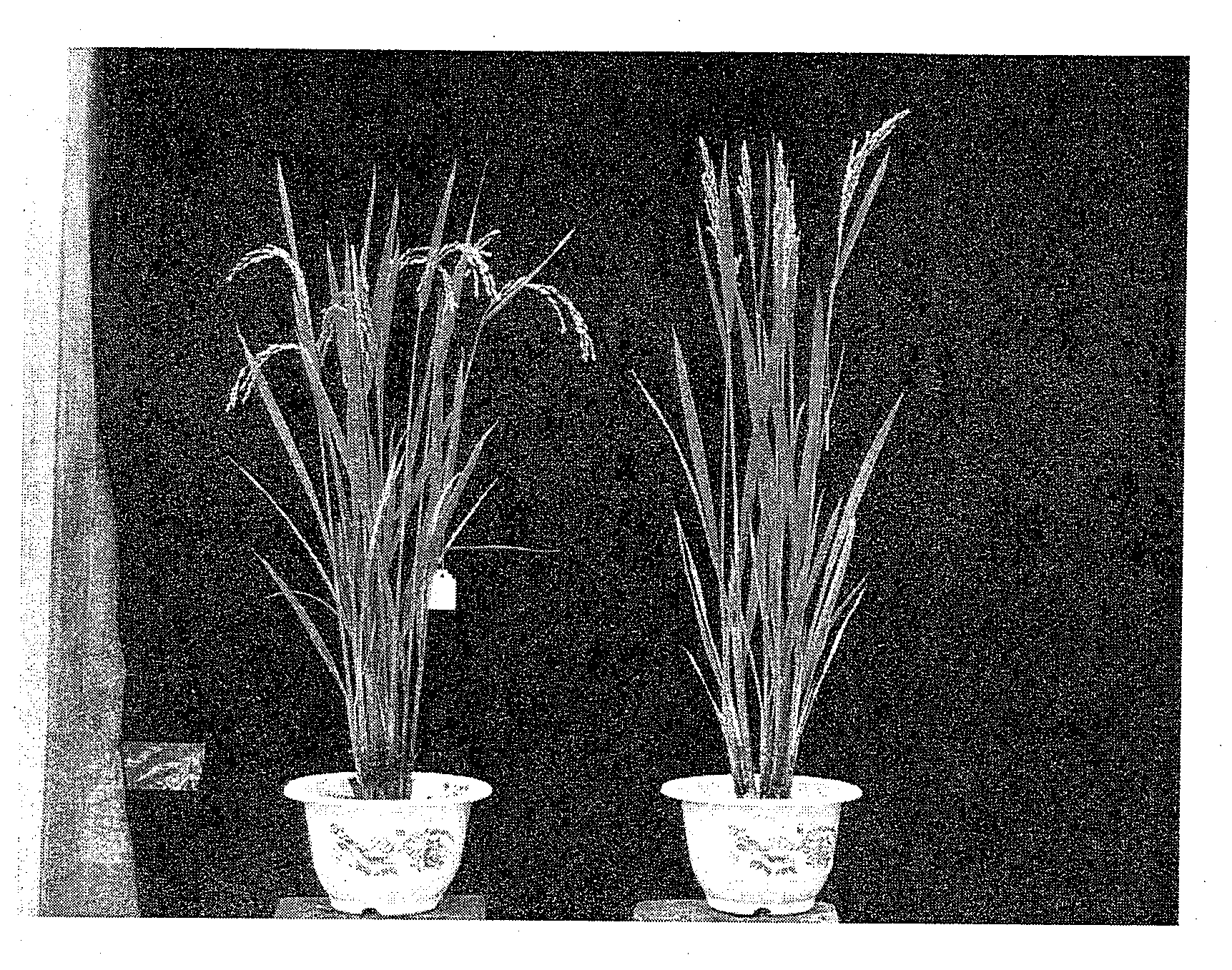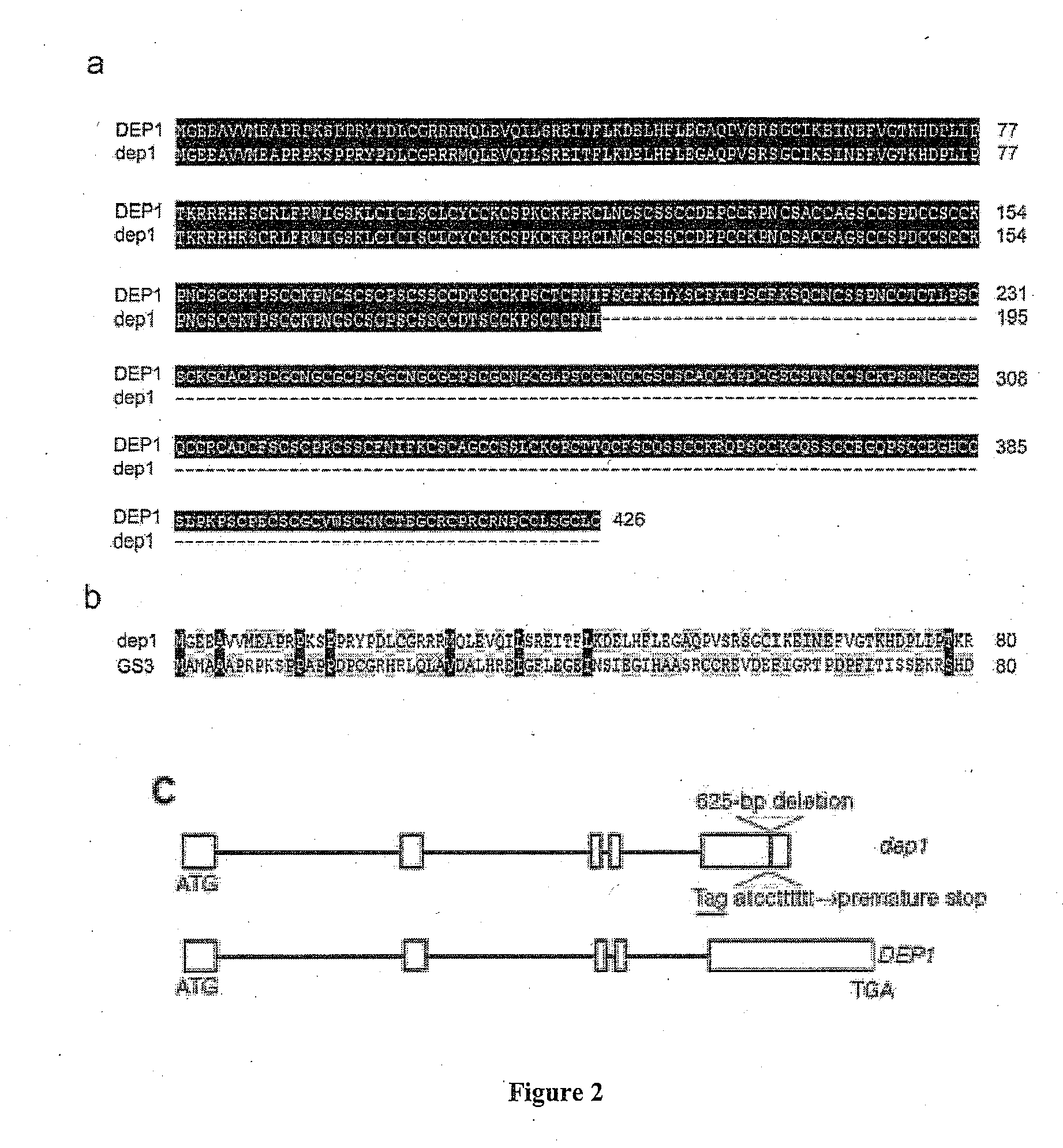Dense and erect panicle gene and uses thereof
a panicle and erect technology, applied in the field of erect panicle phenotype, can solve the problems of food security becoming an ever more serious global problem, and achieve the effects of increasing panicle number, increasing yield, and increasing lodging resistan
- Summary
- Abstract
- Description
- Claims
- Application Information
AI Technical Summary
Benefits of technology
Problems solved by technology
Method used
Image
Examples
example 1
Comparison Between Rice Varieties Shao 313 and Shao 314
[0140]Shao 314 and the precursor to Shao 313 have a background of “Wuyunjing” and were found in the field of Shaoxing Institute of Agricultural Science, Zhejiang Province. Shao 313 was obtained from its precursor by multiple generations of backcross and selection using Shao 314 as recurrent parent, in which 8 generations of backcross were completed.
[0141]Lines Shao 313 and Shao 314 are near-isogenic, though Shao 313 has a dense and erect panicle (see the right side of FIG. 1) and Shao 314 has curved and loose panicle (see the left side of FIG. 1). Sample seeds of both lines were deposited in the China General Microbiological Culture Collection Center (CGMCC, address: Institute of Microbiology, Chinese Academy of Sciences, Beijing, China, P.O. Box 2714, postal code: 100080) on 8 May 2008 under accession numbers of CGMCC No. 2485 and CGMCC No. 2486, respectively. The above deposit was converted into a deposit under the Budapest Tr...
example 2
Measurement of Photosynthesis and Chlorophyll Content
[0146]The measurement of chlorophyll content was performed on rice during the four-leaf stage by collecting leaves of corresponding sites of 313 and 314 respectively, weighing them, and testing chlorophyll content by an ethanol method (Shen, Comm. Phytophysiology, 3:62-64 (1988)). Light absorption peaks at 665 nm and 649 nm were determined, and chlorophyll content was calculated using the following formula: chlorophyll content (mg / g)=pigment concentration (c)×volume of extract liquid×dilution factor / fresh or dry weight of sample. Photosynthesis efficiencies of 313 and 314 were measured between 9:00 AM and 10:00 AM by a method comprising: using photosynthesis system L1-6400 (LI-COR Inc., Lincoln, Nebr. USA), setting different light intensities (250, 500, 750, 1000, 1500, 2000, 2500 μmol photons m−2 sec−1), and measuring net absorptions of CO2 (μmol m−2 sec−1) under corresponding light intensities. Each test was repeated twice.
[0147...
example 3
Measurement of Vascular Bundle Number
[0148]Immature uppermost internodes from top and flag leaves of 313 and 314 were collected and fixed for more than 48 hours by using FAA fixing solution. They were subsequently dehydrated for 30 minutes by using sequentially 40%, 60%, 80%, 95% and 95% anhydrous ethanol. Internodes were subsequently washed with 100% anhydrous ethanol and historesin (Leica Historesin embedding kit, lot 010066, 2022 18500) in a ratio of 3:1 for 3-4 hours, 100% anhydrous ethanol and historesin in a ratio of 1:1 for 3-4 hours, 100% anhydrous ethanol and historesin in a ratio of 1:3 for 3-4 hours, washing twice with 100% historesin, in which the second washing was sustained overnight, and washing with fresh historesin for 1 hour in the next morning. Washed internodes were embedded using 100% historesin and hardener (Leica Historesin embedding kit, lot 010066, 2022 18500) in a ratio of 16:1, and sealed with parafilm. After the embedding agent was sufficiently solidified...
PUM
| Property | Measurement | Unit |
|---|---|---|
| distance | aaaaa | aaaaa |
| Tm | aaaaa | aaaaa |
| temperature | aaaaa | aaaaa |
Abstract
Description
Claims
Application Information
 Login to View More
Login to View More - R&D
- Intellectual Property
- Life Sciences
- Materials
- Tech Scout
- Unparalleled Data Quality
- Higher Quality Content
- 60% Fewer Hallucinations
Browse by: Latest US Patents, China's latest patents, Technical Efficacy Thesaurus, Application Domain, Technology Topic, Popular Technical Reports.
© 2025 PatSnap. All rights reserved.Legal|Privacy policy|Modern Slavery Act Transparency Statement|Sitemap|About US| Contact US: help@patsnap.com



